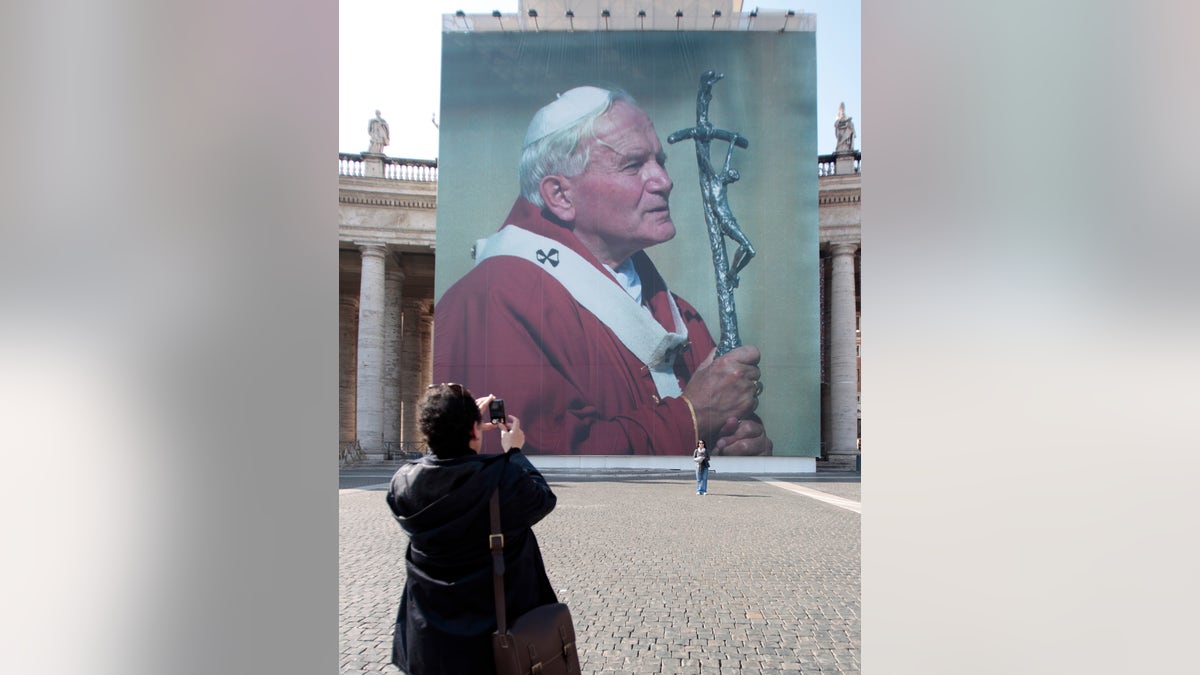
Faithful take a suovenir picture in front of a giant poster of late Pope John Paul II, in St. Peter's square, at the Vatican, April 28, 2011, days before John Paul's May 1 beatification. A prayer vigil on the Circus Maximus, an all-night prayer session in downtown Rome churches and the beatification Mass celebrated by Pope Benedict XVI top the agenda for the three-day event. (AP2011)
Pope John Paul II’s beatification on Sunday may draw as many as a million people to Rome. Well over that number came six years ago when John Paul died, many of them clamoring “Santo Subito!” or make him a saint immediately.
It has not been immediate, although it could have been, had Pope Benedict wanted to proceed that way. Benedict opted against the super-fast track.
But things moved awfully quickly once Benedict waived the normal five-year waiting period before the process can begin (something that was also done, by John Paul II, in the case of Mother Teresa).
While people of various persuasions on the Catholic spectrum – mostly left, but a few right and center -- may be opposed to an official declaration of “Blessed” John Paul, no one should be surprised at the speed.
One thing you notice when you’re traveling with the Pope is that you never hear this announcement on the plane: “We’re currently tenth in line and we expect to be taking off in about 20 minutes.” Popes do get special treatment.
And the overwhelming outpouring of affection for John Paul at his death was a sign that he had stood out from the rest of the crowd of would-be saints.
So do others with a widespread reputation for holiness. Mother Teresa’s beatification moved roughly at the same speed as John Paul’s but no one – with the exception of professional bad-boy Christopher Hitchens – blinked an eye.
So despite a huge backlog of cases at the Congregation for the Causes of Saints, John Paul’s dossier did not sit at the bottom of a pile for years and years. And that’s understandable.
Some of the opposition of to the beatification has been purely ideological, such as Maureen Dowd complaining that Dorothy Day, one of the founders of the Catholic Worker movement, is not yet Blessed Dorothy.
Other opposition is more substantial, and one could certainly make the argument that the saint-makers had to take a closer look at John Paul’s actions during the entire sex abuse crisis.
John Paul’s defenders point out that while many bishops dropped the ball during the crisis, the Pope was precisely the kind of selfless priest the Catholic Church was trying to promote, and that the flood of abuse cases coming to light were largely from before the Pope even took office.
Vatican officials point to statistics showing that cases of abuse within the church actually went down during John Paul’s pontificate while they were going up in society at large.
More troubling for John Paul was his support for the disgraced founder of the Legionaries of Christ, Father Marcial Maciel Degollado. In what may have been one of the most ill-advised phrases of his pontificate, he once referred to Maciel as an “efficacious guide to youth.”
The Vatican later determined that Maciel had abused a number of his seminarians, and fathered several children as well. Maciel was a kind of Church version of Bernard Madoff, a huge fraudster, and had managed to ingratiate himself at the highest levels of the Vatican.
But shortly after he was elected, Pope Benedict had Maciel retire to a life of prayer and penance. Maciel died in 2008, and Benedict ordered an investigation into the Legionaries.
In the end, the Maciel case and the abuse scandal turned out to be a small bump in the road for John Paul’s beatification. Should they have been more than a bump in the road, perhaps a road block? Heaven knows. And that’s where the saints are.
